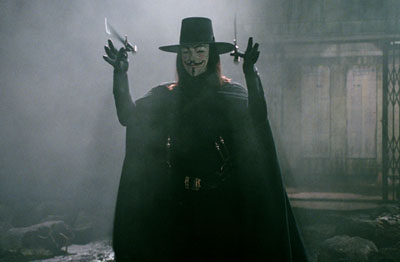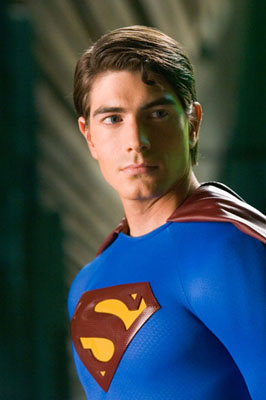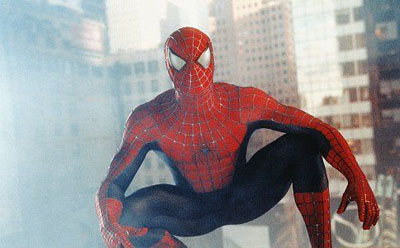
It’s a Bird! It’s a Plane! It’s Another Superhero Blockbuster!
A Look at our Fascination with the Hollywood Comic Flick By Joel Fowler Ah, summertime! That sweet, sweltering time of year when Americans break out the lemonade, lather ourselves in sunscreen, and try to rediscover that leisure time we somehow lost during the beginning part of our year. When the long, lazy days get too heated or too repetitious for us to stand, another seasonal pastime, attending a big-action blowout at our local cineplex, comes into our purview. And, just as you can guarantee there’ll be mosquitoes at a lakeside resort destination, it’s a safe wager that one or two of the bijou offerings, if not the grandest ones on the marquee, will belong to a superhero - those brave men and women who don a cape, create a secret identity, and fight villains who oppose our intrinsic necessity for truth, justice, and the American way.
This year, the superhero season started even earlier, with the Alan Moore graphic novel, V for Vendetta, hitting theaters in March. A multi-million dollar treat usually released in May or June that turned a handsome profit even before its DVD release (earning over $125 million in worldwide box office), Vendetta is just a mere appetizer for a Super-Sized summer that will unleash the rebirth of the Man of Steel, Superman, (an assured $400 million domestic box office champion) facing off against the (possible) final chapter in the X-Men trilogy (of which the first two offerings economically held their own). Yet, it’s no wonder why Tinseltown still keeps cranking out these hero-filled vehicles given the genre’s recent track record. Last summer, Fantastic Four surpassed the box office pundit’s initial projections and scored over one hundred and thirty-five million in its first four weeks, while Batman Begins, Warner Brothers’ retooling of its Caped Crusader with Christian Bale donning the wings, scored not only critical praise but also over $200 million in U.S. ticket sales. In a summer season that saw notable testosterone-filled flops in the sci-fi (The Island – $35 million intake for a film that cost over $120 M) and military (Stealth - $32 million vs. $130 M in production costs) genres, the safest entertainment bets are now being placed on any hero with a secret lair and intense unnatural powers. So, why does this need to see crime squashed permeate so radiantly in our collective cultural consciousness? Why does it seem every blockbuster movie today is based on these protagonists in spandex? While civilizations have always wanted stories of the unexplainable, often attributed to unseen yet omnipresent gods and goddesses, the ‘modern’ interpretation of our paper paladins isn’t very recent at all. Renown University of Notre Dame classics and philosophy professor Dr. David O’Connor rationalizes, “The first clear predecessor of our superheroes is Satan, in John Milton’s Paradise Lost written three and a half centuries ago. This character, endowed with great mental strength, a huge physique, and a wounded heart that can’t heal, seems to me the paradigm superhero. His fallenness is what makes his strength fascinating, rather than merely impressive… But, to have modern superheroes, you have to have the graphic arts. The guy who really set this in motion was William Blake, the unknown genius of Romanticism two centuries ago, who invented the illustrated novel… big muscular bodies, scantily clad and luridly colored, often flying or plunging, engaged in battles with forces they can’t defeat but must resist.” Noted modernist philosopher and founder of the Morris Institute for Human Values, Dr. Tom Morris, further explores this contemporary fascination with the disguised demigods in his book “Superheroes and Philosophy: Truth, Justice, and the Socratic Way”. In a recent interview, the former Notre Dame colleague of Dr. O’Connor explained the crux of his theory, “We love the superheroes because we see them living lives of adventure. But, there is even something more. We admire superheroes for their altruism, their concern for others. Deep in the heart of America, there is still concern for the downtrodden, the helpless, the innocent, and that’s a very good thing. We love superheroes because they overcome the boundaries of self-interest to look out for others, even at great risk to themselves. And, we love to see them win, we need to see good win over evil, and the great superhero stories show us that, as vividly as possible.” This human desire for overcoming adversity may explain why the modern superhero sprang forth during our country’s most economically devastating era, the Great Depression, and rose to the heights of its popularity when foreign aggression was at its apex, during World War II. According to Jim Warden, comic historian and dealer in the original drawings of some notable DC and Marvel artists, “the comic was a relatively inexpensive form of entertainment during the Depression, an escape to a better land where heroes defeated villains. Unfortunately, most pre-WWII comics where destroyed in scrap paper drives, but that’s when the DC characters of Superman and Batman came into prominence.”
So, it only makes sense that the two oldest and well-known pulp idols have dominated the early Hollywood success of the genre. Superman, the vehicle that made Christopher Reeve a household name, earned over $300 million worldwide with its initial release, after the red-caped one debuted in December 1978. In a post-Star Wars era where action-adventure features were in fevered demand, the Man of Steel filled the rapidly developing multiplex theaters with two widely successful sequels and lined the pockets of Warner Brothers (the owners of DC Comics) to a sum of a half a billion dollars. Yet, just with any fad, by 1987, the American public tired of the man from Krypton, with his final installment, Superman IV: The Quest for Peace, flopping in at only $15.7 million in domestic box office receipts. While Warner Bros. may have earned a Best Picture Academy Award last year with Million Dollar Baby, the conglomerate currently has only one Billion-Dollar Baby and his name is Batman. Starting with auteur Tim Burton’s 1989 post-modern dark recreation thought the Joel Schumacher flamboyant (and some would claim paltry commercialistic) 1997 envisioning of the Caped Crusader and his Boy Wonder, Robin, the winged one scored four box office hits, totaling global box office revenues at an astounding $1.25 billion (not to mention the $400 million plus earned through video and television deals). Yet, Superman and Batman are polar opposites on the ‘unreal’ power spectrum. We all know the alter ego of Clark Kent is faster than a speeding bullet, more powerful than a locomotive. But, Bruce Wayne is merely Bruce Wayne in a winged mammal suit. Why do some fans favor the man with the big ‘S’ on his chest, while others prefer what the fictional Gotham City newspapers once dubbed ‘the winged freak’? Dr. Morris hypothesizes, “A lot of people love Superman because of his goodness. He is a fish out of water, an alien living among us as one of us, but he cares for us and wants to fit in. A lot of basically nice people often feel a bit alienated from the social Darwinism that too often seems to separate the winners from the losers in our society. They love Superman because of the fantasy and hope that goodness can win in the end. I think Batman appeals to all of us who know we have abilities we haven't developed, and we see in him the paradigm of self-development, both intellectually and physically. He intimates that it's all within our reach, if we just work hard enough, with sufficient focus, and maybe a touch of obsession thrown in. In his case, the most neglected virtue in the modern world, self-discipline, shows what it's capable of producing.” And what about the Marvel Comic characters that seem to stumble into their unreal abilities? “Realistic optimists love the flawed superheroes who gained their powers in an accident or tragedy, like Spider-Man, Daredevil, or The Fantastic Four, because these superheroes show that we can overcome the suffering and unpleasant surprises that inevitably come into our lives, and we can prevail, however much hassle life still throws at us along the way.”
And much like the progression of the comic book business where Spidey and the X-Men suppressed Batman and Superman’s popularity, Marvel Comics has quickly supplanted DC in terms of Hollywood success as well. The company of Stan Lee has compiled a recent level of box office totals that can best be described as unfathomable, making the firm’s first attempts, such as the ill-fated 1991 straight-to-video lead balloon Captain America and the late 1990’s vampire slaying Blade trilogy’s three hundred and fifty worldwide receipts, seem like small change. Marvel’s winners seem to come in all sizes. Their first grand experiment, 2000’s X-Men yielded $250 million worldwide with its sequel, X2, almost doubling that total ($406 M). This summer’s projections for X3 are understandably off the charts given the group’s past growth rate. Spiderman – isn’t that all that needs to be said? You’d have to be living under a cultural crater not to know of the web-slingers box office acumen. Summer of 2002 saw the red-suited arachnid pull in over $800,000,000 worldwide (with half, $400 M, being domestic tickets alone). And 2004's sequel, Spiderman 2? Economically speaking, there was more of the same - $373 M domestic and an estimated $750 M global. So, why did Spiderman and his fellow band of otherworldly warriors become not only an acceptable form of adult entertainment, but in some sense the preferred genre for post-adolescent males who crave action movies? According to Dr. Morris, “My son (and co-author), Matt Morris, likes to point out that various forms of music, like rock and country, have gotten more complex over the past fifty years. In many fields of pop culture, there has been a general evolution over time. Now, the great comics have generated blockbuster movies. All it took was a little psychological sophistication and the best of contemporary special effect, and the superheroes have moved into mainstream entertainment.”
And, Marvel is determined to keep the mainstream stature of the comic flick in vogue, as the new offerings just keep coming. Some of the titles in development include the Nicolas Cage hell-bend motorcyclist Ghost Rider, the kung fu flavored Iron Fist, and the alcoholic billionaire forced to assume a metal façade Iron Man. John Singleton is even reformulating the first black superhero Luke Cage – that is, if you don’t consider Singleton’s Shaft a superfly superguy (and we won’t even talk about Halle Berry’s unwatchable Catwoman). However, there have been some gaffs in the superhero genre. Recent Best Director winner Ang Lee’s moody The Hulk sunk quickly in the summer of 2003 (less than $140 M domestic – more than the estimated production and marketing costs). For the off-season heroes, the results have been even worse, with titles failing to make their money back including The Punisher ($34 million in April 2004), the aforementioned Catwoman (earning only half ($40 M) of the estimated budget ($85 M) in late July 2004), and Jennifer Garner’s unenergized Elektra ($24 M in January of 2005). Why do certain superhero movies fail? Dr. O’Connor finds the answer in the very simple truth of entertainment – is it any good? “As we get used to new film technologies and get over the “Oh, Wow!” feeling of special effects, the stories will have to get better to hold the audience. Spidey [probably] won’t make it to [sequel number] 12 – but I’m hoping for Captain America!” Which brings up a good point - why, in a post-9/11 world, do you think Captain America hasn’t been brought back on-screen to defeat fictitious terrorists, as he did with Hitler in World War II (when the character was originally invented as a propaganda idol)? Dr. O’Connor responds, “A good superhero needs a great villain to bring out both his strengths and weaknesses. Terrorists really aren’t good villains in this sense. The best villains have something attractive in them… [so] it’s hard to see Captain America finding anything tempting about a terrorist.” So, with a rash of recent failures and an onslaught of substandard guardians of goodness on the way, do you see the comic book movie genre losing its popularity any time soon? Dr. Morris reassures us, “Since we could tell stories and draw pictures, we’ve been portraying larger than life heroes and villains… Superhero comics are as American as Jazz, Blues, Muscle Cars, MTV, and Krispy Kreme Donuts… [and] I think we’ll be seeing the superheroes for a long time, as long as they continue to attract good writers and artists. Film goes through cycles, but I suspect we’re in the beginning stages rather than the end times for great superhero movies.” Comic book fans have the following to look forward to this year: V for Vendetta on March 17th, X-Men 3 on May 26th, Superman Returns on June 30th. And 2007 holds Ghost Rider (February 16, 2007), Spider-man 3 (May 4, 2007), Fantastic Four 2 (July 4, 2007), Sin City II, Hellboy 2, 30 Days of Night, Frank Miller's 300 and The Punisher 2. | ||||
|
©2006 Thomas Huff and Joel Fowler, BlownPotential.com Any suggestion? E-mail tom@blownpotential.com. |



